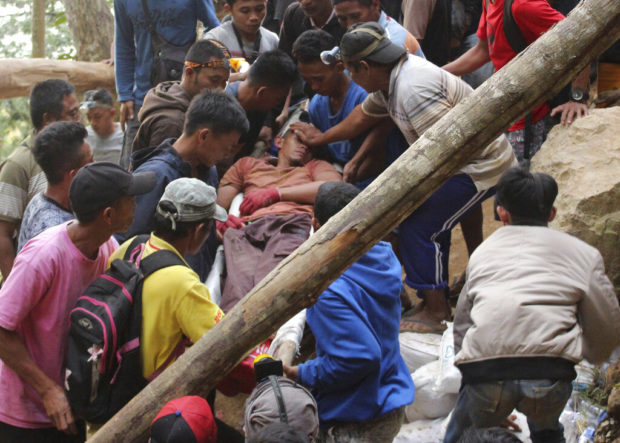Deaths from Indonesia mine collapse rise to 6, dozens buried

Rescuers carry a survivor from inside a collapsed mine in Bolaang Mongondow, North Sulawesi, Indonesia on Feb. 27, 2019. AP
BOLAANG MONGONDOW, Indonesia — Rescue workers used makeshift stretchers to haul victims of an Indonesian gold mine collapse through steep jungle terrain to safety, as the death toll rose to six Thursday and dozens remained trapped in the debris.
Nineteen people had been rescued and about 40 were still buried as of Thursday, two days since the unlicensed mine collapsed, said Abdul Muin Paputungan, a disaster official in North Sulawesi’s Bolaang Mongondow district.
Photos showed a trapped miner’s arms and head jutting through a gap in rocks and rescuers toiling through the night in arduous conditions.
A woman who took her missing husband’s ID to an emergency command post cried out in anguish when an officer showed her a photo of a dead victim they believed was her husband, video showed.
“God forgive me,” she screamed.
Wooden structures in the mine collapsed Tuesday evening due to shifting soil and the large number of mining holes.
Article continues after this advertisementThe national disaster agency said at least 140 people from different agencies were involved in the rescue effort. It said there was an urgent need for body bags.
Article continues after this advertisementRescuers were using their bare hands and basic tools to search for the missing in the remote, inaccessible location. They fashioned stretchers from tree branches, twine and other material. Photos showed rescuers working in mine tunnels.
Informal mining operations are commonplace in Indonesia, providing a tenuous livelihood to thousands who labor in conditions with a high risk of serious injury or death.
Small artisanal and often unauthorized mining is rising in many parts of Asia and Africa. A study by the Intergovernmental Forum on Mining, Minerals, Metals and Sustainable Development found the number of people engaged in such mining had risen to more than 40 million, up from 30 million in 2014 and 6 million in 1993.
Landslides, flooding and collapses of tunnels are just some of the hazards. Much of the processing of gold ore involves use of highly toxic mercury and cyanide by workers using little or no protection. /ee